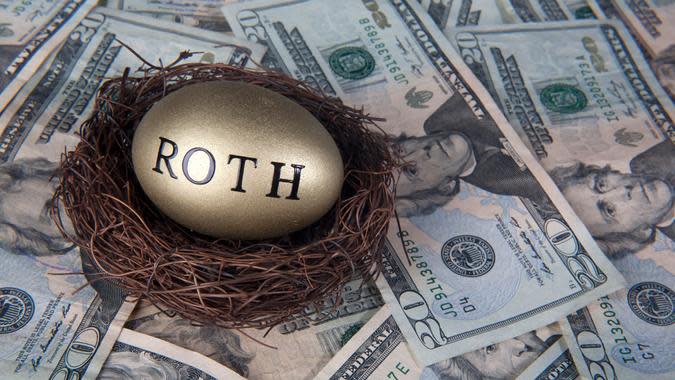How Not To Screw Up Your Retirement Once You’re There

You’ve put in your time in the working world and saved up a healthy nest egg so that you can enjoy your golden years with ease. But even if you’ve done everything right up until now, there are ways you can unwittingly derail your retirement once you’re there.
Retirement Planning: How Much the Average Person 65 and Older Spends Monthly
Also: How To Get $340 a Year in Cash Back – for Things You Already Buy
GOBankingRates spoke to retirement planning experts to get their best tips on everything from Social Security to investing. Follow their advice to thrive in this next phase of your life.

1. Wait To Claim Social Security
Claiming Social Security benefits too early is one of the mistakes even smart people make in retirement. If it’s financially possible for you to delay claiming Social Security, you can maximize your benefit by waiting until age 70 to collect.
“Do you want to travel extensively in your golden years or finally build your dream home? You might benefit by delaying … Social Security benefits,” said Judith Corprew, executive vice president at Patriot Bank, N.A.
See: 4 Social Security Shakeups from Biden That Could Hit Your Wallet by 2024
Read More: Latest Social Security Proposal Would See Millions ‘Receive More, and No One Would Receive Less’

2. Create a Retirement Budget
Since you’re now living on a fixed income in retirement, it’s vital to create a budget — and stick to it. Otherwise, you might go bankrupt in retirement.
“Create a realistic plan for your retirement by preparing a budget of anticipated resources and expenditures,” Corprew said. “Remember to (also) plan for the unexpected. Nobody wants to experience tragedy, but if you have a comprehensive plan, it will help you to weather the storm regardless of what happens.”
Check Out: 10 States To Avoid If You’re Living on Just a Social Security Check

3. Discuss Your Retirement Plans With Family Members
“Oftentimes a cooperative approach will allow you to do more in retirement for less,” Corprew said. “For example, if you dream of spending the cold winter months at the beach in Florida, entering into a timeshare or other form of divided ownership of vacation property with a relative could provide the vacation you want at a lower cost.”
But make sure you don’t get suckered into a timeshare scam — this is a common retirement gotcha.

4. Invest In ‘Safe’ Investments
Not picking the right investments is a retirement mistake that wastes your money.
“One of the biggest mistakes retirees make is not having any or enough ‘safe’ money investments,” said Wayne K. Maslyk Jr., president at Great Lakes Benefits and Wealth Management. “They get pitched by a broker, stock jock or variable annuity sales person, and all of their money ends up going into the market.”
Maslyk advises against putting all of your life savings in investments that could potentially lose money.
“A retiree should have a portion of their investable money in ‘safe’ accounts like CDs, fixed annuities and government bonds, so when the market takes a beating, at least a chunk of their life savings is not going backward,” he said.

5. Question Conventional Financial Wisdom
A lot of common financial rules of thumb aren’t actually that effective.
“Avoid cookie-cutter heuristics, such as the so-called ‘4 Percent Rule’ for setting portfolio withdrawal rates, the ‘100 minus your age’ asset allocation guideline, and the popular notion that investors should spend taxable accounts, then tax-deferred accounts and then tax-free Roth accounts, in that order,” said John “J.R.” Robinson, founder at Financial Planning Hawaii. “There is abundant research that demonstrates that these concepts are both dated and sub-optimal.”
See: 10 Brilliant Ways To Reduce Your Taxes in Retirement

6. Optimize and Minimize Income Taxes
The income taxes you owe will depend on your portfolio withdrawals, Social Security benefits and the order in which you spend money from various retirement savings accounts.
“Income tax optimization/minimization is the low-hanging fruit in retirement income planning,” Robinson said. “Income tax is typically among the largest expenses for retirees in the mid-market affluent space and is typically the one budget item that they do not mind cutting. Optimization often requires coordinating portfolio withdrawals with Social Security retirement benefits, and carefully plotting account spending order.”

7. Determine the Best Account Spending Order for Your Financial Situation
Should you spend down for your 401(k), IRA or Roth IRA first? The answer depends on your individual financial situation, so make sure you understand the implications of the order you choose.
“Account spending order is often a critical element of tax optimization,” Robinson said. “The reason the aforementioned standard spending-order mantra falls apart is that depending upon the retiree’s baseline Social Security and pension income, it may make sense to withdraw from tax-deferred retirement accounts — such as an IRA or 401k — first if such withdrawals are taxed at low marginal rates, and/or it may make sense to take Roth distributions to avoid capital gains tax in taxable accounts, or to avoid subjecting Social Security benefits to taxation.”

8. Have a Portfolio Withdrawal Strategy
You might be retiring with investments across different asset classes. Before you start cashing out these investments, make sure you have a strategy in place.
“Portfolio withdrawal strategy is arguably the most underrated factor in determining portfolio sustainability,” Robinson said. “Most financial planning software and many published research papers on retirement income planning implicitly assume that proportional withdrawals from each asset class in conjunction with annual re-balancing is an efficient withdrawal strategy. There is ample published research demonstrating that it is not.”
“Specifically, academic researchers have demonstrated that portfolio sustainability may be enhanced by adopting strategies that avoid spending equities early in retirement, and particularly during down years,” he continued. “Cash/bonds first withdrawal strategies and more sophisticated dynamic withdrawal strategies have been shown to have dramatically better outcomes.”
Social Security: No Matter Your Age, Do Not Claim Benefits Until You Reach This Milestone

9. Minimize Portfolio Expenses
Portfolio expenses such as transaction costs, internal mutual fund/ETF fees and expenses, and investment advisory fees can really eat away at your retirement savings.
“Minimizing portfolio expenses is an important element determining how long one’s nest egg may last,” Robinson said. “When planning for a 25- to 30-year retirement, two identical portfolios with the same withdrawal strategies will have significantly different sustainability profiles with expense differentials of as little as 1%.”
Shop around for a broker with low fees to maximize the size of your nest egg.

10. Invest In Single Premium Immediate Annuities and Deferred Income Annuities
“In the absence of a bequest motive, withdrawal rates may be increased and portfolio sustainability enhanced by allocating a portion of one’s retirement portfolio to single premium and/or deferred annuity contracts,” Robinson said. “A fair amount of academic research has shown that retirees would benefit from having a greater portion of their retirement income from guaranteed sources including SPIAs and DIAs.”

11. Don’t Overlook Home Equity
If your funds are running low, you should consider selling your home and downsizing.
“For many retirees, their house is their single largest asset,” Robinson said. “It should not be overlooked as a source of retirement income in the later years of retirement if portfolio depletion seems likely.”
Retirement Savings: Experts Say This Magic Number Is the Key — and It’s Not $1 Million

12. Consider Getting Long-Term Care Insurance
“(Retirement is) a good time to look at minimizing risks by looking into new insurance such as long-term care insurance — especially if you are married and worry about spending the retirement nest egg if one of you has a significant health event,” said Scott Bishop, CPA, CFP, executive VP of financial planning at STA Wealth Management, LLC, in a blog post.
Long-term care insurance can help offset the costs of healthcare in retirement, which is the biggest financial burden on retirees, a GOBankingRates survey found.

13. Don’t Delay Applying for Medicare
“Retirees who are nearing age 65 should make sure to apply for Medicare within a seven-month period — three months before you turn 65, the month you turn 65 or three months after you turn 65,” said Mario Hernandez, partner and director of operations at Gemmer Asset Management, LLC. “After this period, a retiree will pay a 10 percent penalty each month for the rest of the retiree’s life. This applies to Part B premiums. Retirees who delay applying for Medicare could be haunted by this mistake for the rest of their lives.”

14. Consider Converting Traditional 401(k) Plans and IRAs to Roth Accounts
Converting to a Roth account is one of the brilliant ways to reduce taxes in retirement.
“At age 70 ½ you are required to start withdrawing Required Minimum Distributions from traditional IRAs and for 401(k)s if you’re no longer employed,” said Luis F. Rosa, CFP, EA, founder at Build a Better Financial Future, LLC. “These distributions will be considered taxable income, and can trigger tax on your Social Security benefits.”
Currently, if your modified adjusted gross income is between $25,000 and $34,000 as a single individual, you might pay income tax on up to 50% of your Social Security benefits. If it’s more than $34,000, the figure goes up to 85% of your Social Security benefits. For married couples filing jointly, if your modified adjusted gross income is $32,000 to $44,000, up to 50% of the benefits can be taxed, and if income is over $44,000, up to 85% of the benefits can be taxed.
“Consult with your tax advisor and/or financial planner to see if converting certain funds to a Roth IRA over the upcoming years is a smart choice since the converted funds will be considered taxable income in the year converted,” Rosa said. “However, funds withdrawn from the Roth IRA will not be considered income if held at least five years, and the money is withdrawn after age 59 ½. This can potentially save you later by not having that money count toward the formula that determines whether or not your Social Security benefits are taxable, and tax brackets might be higher in the future if the current brackets and provisions are not extended beyond 2025.”
See: 6 Things Social Security Deducts From Your Benefits

15. Take Advantage of the Tax Benefits That Come With Homeownership
If you own a home, you might qualify for certain tax breaks.
“Make certain that you take advantage of any discounts available to seniors regarding real estate taxes,” said Morris Armstrong, enrolled agent at Armstrong Financial Strategies. “Many states and municipalities offer a reduced rate or tax credit to people over the age of 65. These may be limited depending on your income.”

16. Put Your Savings Into a High Interest-Earning Account
The average savings account rate is 0.40% as of June 2023, but you can earn 3% and more if you shop around for the best rates.
“If you have surplus funds, make sure that they are in a savings account,” said Armstrong, who noted that you’ll earn $200 in interest annually on $10,000 put into a savings account with just a 2% interest rate.

17. Make Charitable Contributions Directly Through Your IRA
“If you are over the age of 70 ½, it is strongly recommended that you consider doing what is called a Qualified Charitable Distribution — this is where you have your IRA make the charitable contribution directly,” Armstrong said. “The amount that is contributed to charity helps satisfy your Required Minimum Distribution — the amount that you must take out — but does not count as taxable income. Effectively, you are getting the deduction for the charitable contribution without itemizing. You may also benefit on your state tax return and benefit from bracket creep with regard to Medicare B and D charges.”
Check Out: 6 Types of Retirement Income That Aren’t Taxable

18. Consider Relocating To Save on Living Costs
The majority of Americans who said they would consider moving in retirement said they would move for better weather or a change of scenery, a GOBankingRates survey found. But moving can also help you to save on housing costs and taxes. If these savings are significant, moving could be a great way to stretch your retirement nest egg further.

19. Meet With a Financial Advisor Regularly
As you go through your retirement, your financial situation can change, as can living costs, tax laws, the market and other external factors. Regularly checking in with an advisor about how to best maximize your financial situation can help you to stay on track amidst any changes.
More From GOBankingRates
The 5 Most Effective Budgeting Methods -- and How to Use Them
Experts: Make These 7 Money Resolutions If You Want To Become Rich on an Average Salary
This article originally appeared on GOBankingRates.com: How Not To Screw Up Your Retirement Once You’re There
